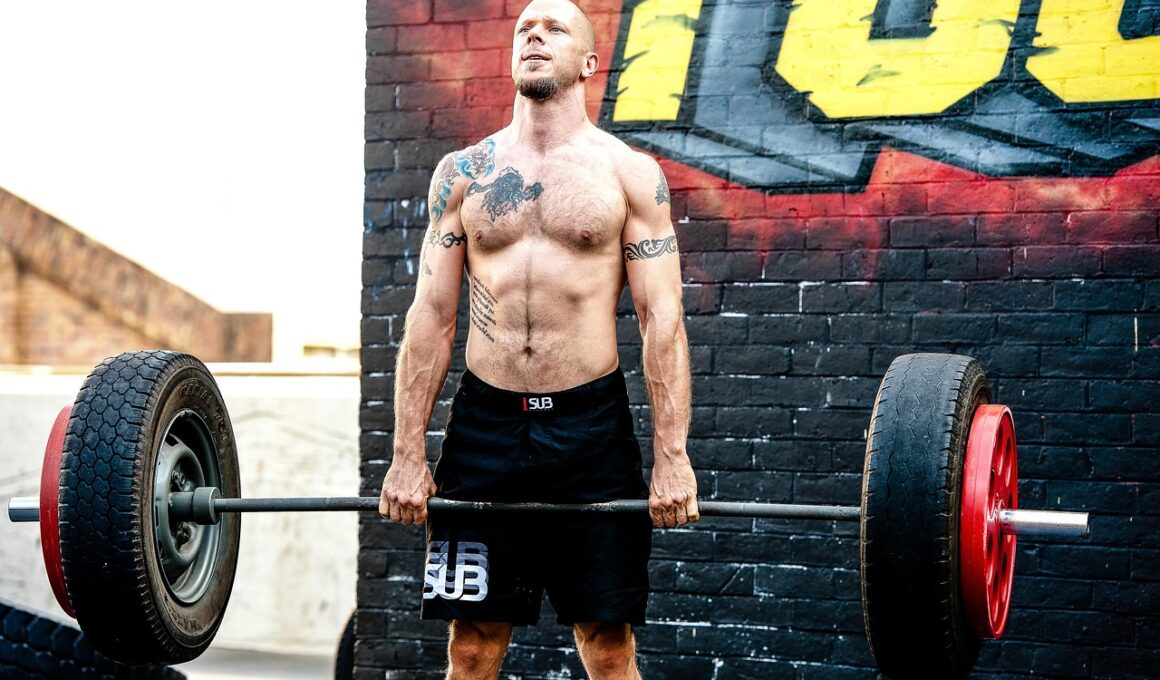Improving Your Deadlift in CrossFit Powerlifting
Deadlifting is a fundamental aspect of CrossFit powerlifting, and mastering this lift can lead to significant gains in strength and performance. As you attempt to improve your deadlift, it’s essential to concentrate on various factors that influence your success. Focusing on proper form should be your first priority. A solid deadlift requires keeping a neutral spine to avoid injury and effectively transferring power from the ground through your body. Engage your core muscles and work on your grip to stabilize your lift. Training with variations like sumo or deficit deadlifts can help target different muscle groups and improve overall strength. Ensure that you incorporate progressive overload into your training plan, gradually increasing weights while maintaining correct form. Consistency and patience during your workouts lead to increased strength and confidence in your deadlift. Additionally, don’t neglect recovery strategies, as allowing your body to recuperate is critical. Supplementing your workouts with mobility exercises can significantly enhance your form, enabling you to lift more. Consider consulting experienced coaches for personalized guidance, tailored programming, and insightful feedback. Such expertise can accelerate your progress toward achieving your deadlift goals.
To further improve your deadlift, it’s essential to pay attention to your nutrition and overall health. Fueling your body with the right nutrients enhances your strength, stamina, and recovery. Regularly consume a balanced diet that includes a mix of proteins, carbohydrates, and healthy fats to support muscle growth and repair. Consider involving lean meats, dairy, nuts, and legumes in your meals. Remember to stay hydrated, as water plays a crucial role in performance. During your training, track your progress and take notes on lifts, feelings, and energy levels. These insights can pinpoint areas needing improvement. Developing a strong mental game is equally important. Be aware of your mindset during workouts, as it can significantly influence your performance. Visualization techniques can help you picture a successful lift before attempting heavy weights. Create specific, measurable, attainable, relevant, and time-bound (SMART) goals for your deadlift. These benchmarks can motivate you throughout your training. Monitoring these goals allows for adjustments in your programming as you progress. Surrounding yourself with a supportive training community kicks up motivation and accountability levels, providing a positive environment for growth and development.
Incorporating Strength Training
Integration of accessory exercises is vital for developing key muscles engaged during deadlifting. Exercises like Romanian deadlifts, pull-throughs, and barbell squats target major muscle groups essential for a strong deadlift. Additionally, incorporating hamstring and glute-focused movements allows for a balanced program. This ensures that you develop both the posterior and anterior chains required for lifting heavy. Deadlift variations, such as pause or single-leg deadlifts, can aid in building strength and stability. It’s advisable to periodically reassess your training regimen. Regular assessments provide insights into necessary adjustments to optimize your progress. If you’re feeling fatigued or not seeing improvements, consider deloading weeks where you reduce training volume or intensity. This period gives your muscles a chance to recover fully, enhancing your overall performance. Also, it’s sensible to include mobility and flexibility sessions in your weekly routine. Stretching and mobility exercises can aid in maintaining proper form, contributing to fewer injuries and a longer lifting career. Select stretching routines focusing on hip flexors, hamstrings, and back to ensure optimal movement patterns.
Tracking your progress is crucial for improvement in your deadlift. Keep a workout log that records the weights lifted, sets, and reps performed during each session. This way, you can visually see your gains over time and adapt your training plan accordingly. Utilize video recording on your lifts to analyze your form. Revisiting your form through video can highlight inefficiencies and enable necessary adjustments. It also helps to get feedback from knowledgeable coaches who can provide professional insights on your technique. Refocusing on weaknesses, whether they are physical challenges or mental blocks, can significantly augment your training. Consider establishing a strong warm-up routine to prepare your muscles for heavy lifts. This routine can include dynamic stretches, mobility drills, and lighter warm-up sets. Warming up effectively lowers the risk of injuries and primes your body for maximum performance. On the day of your deadlift training, ensure your focus remains sharp. Minimize distractions and concentrate only on the task at hand. Approach your workouts with a positive attitude, embracing challenges as opportunities for growth. This mindset shift can be transformative in achieving your lifting potential.
Mindset and Mental Preparation
A strong mental approach is as critical as the physical preparation when aiming to improve your deadlift. Mental fatigue can thwart your performance, but cultivating a powerful mindset can drive exceptional achievements. Establish pre-lift routines that include visualization of successful lifts and positive self-talk to reinforce your confidence. Techniques such as mindfulness and breathing exercises can help center your focus and reduce anxiety related to heavy lifts. Setting performance milestones, rather than solely focusing on max lifts, can alleviate pressure and promote steady progress. Emphasizing the importance of mindset can enhance resilience against setbacks and insecurities. Find what motivates you and drive that energy into your training. The camaraderie within CrossFit communities provides a support network that can elevate spirit levels. Engaging with peers during workouts encourages a competitive atmosphere that stimulates your improvements. Celebrate small victories, no matter how minimal they may seem. Acknowledging these accomplishments fosters a sense of fulfillment and propels you further toward your ultimate deadlift goals. This newfound confidence reflects in your lifts, leading to an upward trajectory in strength and skills.
Finally, balancing all elements of training, nutrition, recovery, and mindset supports a holistic approach to improving your deadlift in CrossFit powerlifting. Adopting a comprehensive training plan will help you avoid the mistakes beginners often make, allowing for steady and long-term progress. Surround yourself with uplifting, dedicated individuals who share similar goals, as this encourages a healthy and competitive atmosphere. Consistently pursue education around lifting techniques will fine-tune your skills and instill good habits early on. Engage in seminars or workshops offered in the CrossFit community to broaden your understanding of lifts. The strength gained from your deadlift spills into other lifts, boosting your overall performance in CrossFit. Regularly measure your progress against set goals to ensure you’re on track. Utilize both numbers from workout logs and qualitative feelings before and during lifts. Such data helps optimize training routines based on your physical condition and mental state. There’s no one-size-fits-all solution; every individual’s journey is unique in the pursuit of strength. Keep experimenting with what works for you and stay motivated to achieve your personal best in deadlifting.
Your deadlift journey in CrossFit powerlifting enriches not just your physical strength, but also your overall health and wellness. The determination and hard work invested in training positively reflect in other life aspects, fostering resilience and discipline. Deadlifting engages large muscle groups and efficiently boosts overall conditioning. Manifesting progress in the deadlift will instill a sense of achievement, bolstering your self-esteem. Overcoming challenges in training cultivates a strong work ethic that extends beyond the gym. Given the complexities surrounding deadlifts, expect a blend of successes and struggles as you refine your technique and strength. Enjoy the process, and let your passion for lifting shine. Each session contributes to your larger fitness goals, enhancing your capability. Upon completion of this journey, not only will you reach impressive lifting milestones, but you will also develop as an individual. The dedication attributed to training will manifest in countless other successes throughout your life. Breathe in the experience, learn from the challenges, and relish the growth. Approach every lift with excitement and a willingness to adapt to experience and gain strength. Every effort edges you closer to becoming a stronger, more accomplished lifter.
Conclusion
In conclusion, improving your deadlift in CrossFit powerlifting is a multifaceted endeavor requiring dedication and strategic planning. Focus on essential components such as technique, nutrition, mindset, and accessories that enhance your performance. Emphasizing progressive overload while maintaining correct form solidifies the foundation of your strength. Prioritize recovery to maximize your output and prevent injuries, ensuring longevity in your lifting journey. Involve community support for motivation, allowing you to remain accountable and engaged. These strategies, along with regular assessments, will help you navigate your progress efficiently. Deadlifting is not just about lifting heavier weights; it applies to the holistic enhancement of your athletic capabilities. Be patient with yourself, and remember that each improvement, no matter how small, contributes to your overall success. Celebrate your achievements along the way, as these milestones boost morale and motivate further progress. Developing a formidable deadlift ultimately leads to greater confidence in other CrossFit exercises as well. Maintain enthusiasm as you evolve into a skilled lifter. With every session, persistently refine your approach, and watch your hard work translate into impressive results.


